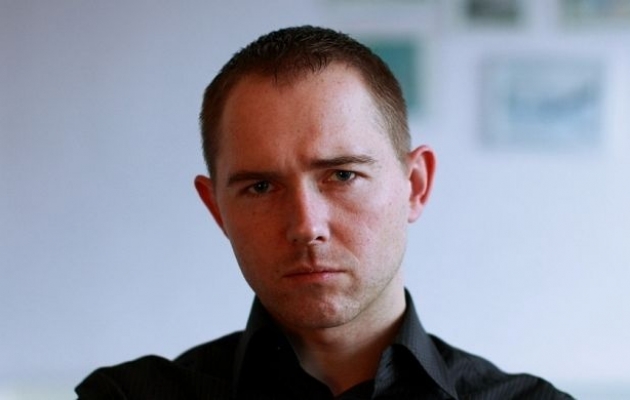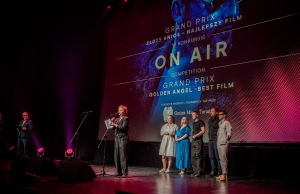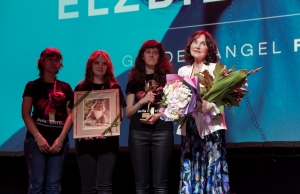A night with a shaman and a wild tribe. Two different film artists at Tofifest.

What can two so different films, as the latest Polish productions Walpurgis Night and Walser, have in common? It's the Tofifest festival. Both authors of the mentioned artistic film work have come to Torun.
To have a contact with the audience is rewarding enough.
The viewers that stayed after the screening of Walpurgis Night to have a late night discussion with Marcin Bortkiewicz did not regret their decision for sure. The meeting offered a uniquely open and easy-going atmosphere, in which the dirtector revealed many previously unknown details about working on the film.
Marcin Bortkiewicz gave an insight into the genesis of the film and explained that it was made via "communication lines", so to speak. The film is based on a monodrama titled Diva by Magdalena Gauer. However, Bortkiewicz decided to enrich the plot with another character, which practically led to rewriting the entire dramaturgy in the film. He referred to a very peculiar cooperation with Magdalena Gauer, saying: 'For a very long time, I was limited only to contacting her by phone. It was the first rehearsal with actors that we finally met in person.' The same applies to the artistic supervisor of the film. The communication between Marcin Bortkiewicz and Jerzy Antczak was possible mostly via the Internet.
Fortunately, it was all a different story with Malgorzata Zajaczkowska, who portrayed the opera singer Nora. She and Marcin Bortkiewicz have been friends and he wanted to cast her one of his film productions, for a long time. When in Torun, Bortkiewicz said that her role in Walpurgis Nacht was practically her debut as a leading actress. He referred to her on-screen incarnation as an "American-like role", since the character she portrayed is very distinctive, expressive, and very distant from the roles the actress has played so far. 'So, my first task was to find a beast in Malgorzata,' he recalled. Quite interestingly, the actress revealed that Nora was still inside her, long after the film had been completed, and she decided not to play any more "mothers and aunts", ever again.
Walpurgis Nacht was made as a film noir. The director emphasised that it took a lot of work to build characters in the film, so as to make them indefinable and ambiguous, which would force the audience to ask themselves questions all the time, and also leave some issues unclear and incomplete, after watching the film. The visual aspect of the film was also very meticulously prepared. 'It was for a reason that we dyed Malgorzata's hair red and painted the walls in irritating green, both of which would look bad in a colour picture, but turned out to be perfect for a black and white film,' explained the director.
Our guest had also a lot to say about film awards. He summed up that the mechanism behind the awarding process was somewhere "between business and the wheel of fortune", and that was rewarding enough for him to participate in festivals and have the possibility of coming into contact with audiences.
Future in the camera of Zbigniew Libera
The author of Walser took us for a journey to a completely different film planet. The new tribalism, the sickness eating away at modern cinema, creating an artificial language, the problem of the exploitation of nature by man, and the vision of the end of our civilisation – all that was discussed by Zbigniew Libera, during the meeting after the screening of his latest film, in Torun.
The film "takes place" in an undetermined future, although it is not the traditional science-fiction genre that presents visions of the world that is as different from our present world, as it is only possible. When in Torun, Libera said that the future would probably be not so much different from the present, and differences would only be limited to the use of alternative materials. 'The future does not have to be about ultra-modern technologies and one of the possible options is going back to a tribal world,' he said, adding that 'The future may bring the end of the civilisation as we know it today.'
Somebody wanted a definition of the so-called "new tribalism". The answer offered by Libera to the audience in Torun came as a surprise! He defines the idea as a conflict, for example between Bydgoszcz and Torun, or as the fights between football fans from different teams. 'What makes the modern man different from the tribal man is first and foremost the way they communicate,' said Libera. He also mentioned that the modern man treats nature as an object, having its total exploitation as the primary objective.
One of the questions to the artist was about the language used by the characters portrayed in Walser. The language of the Conteheli tribe has been created by Robert Stiller, a brilliant translator and linguist. Zbigniew Libera emphasised that he took pains to create a complete language system with its grammatical structures, so as to make actors think in the new language. It is an interesting detail to know that it is almost impossible to refer to the past, using the Conteheli language, which indicates that they can only express the present time.
The discussion about Walser soon transformed into a discussion about the condition of cinema. According to Libera, 'modern cinema, including Polish cinema, suffers from a peculiar disease.' Our guest defined the disease as "newspaperisation", which is manifested by dull and veristic telling of a certain story. Libera sees cinema as meaningful, when the camera is used to show something that would otherwise remain invisible. His film work, Walser included, constitutes an attempt to save the Tenth Muse from that "newspaperisation".
Artur Eichhorst, Press Office of Tofifest
Also in this section
- Idea
- Sections
- Awards
- Jury of 2025 On Air Competion
- Archive




